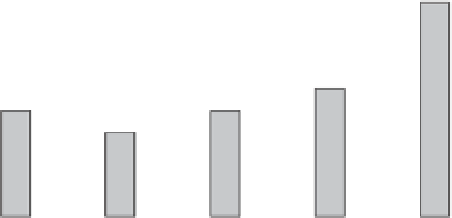Agriculture Reference
In-Depth Information
for cars in Germany are, for example, analysed
according to the VDA 270 standard, using an
inconsistent scale for evaluating the samples,
starting with objective criteria for low-odour
samples and changing to hedonic criteria for
high-odour samples. This is even in contradic-
tion to the basic rules of sensors, resulting in
less reproducible results.
Where the odour of natural fibres is con-
cerned, a two-step evaluation that, in the first
step, uses an objective scale and, in the second
step, a hedonic one has been shown to be opti-
mal (Fischer
et al
., 2004b). In Fig. 10.8, the
results of identical samples evaluated by (i)
VDA 270 and (ii) the FIBRE method (evalua-
tion by objective intensity scale) are compared,
displaying clearly the lower standard deviation
obtained by the FIBRE method.
Another interesting result of this study is
the reduction of the odour potential of hemp
by enzymatic treatment in order to remove
the pectins. When hemp is exposed to low
or medium temperatures (<150°C) during
processing, the odour of hemp treated
enzymatically is much lower than the odour of
raw hemp (sample GDE02, see the section
below on tested fibres for details), which con-
tains more pectins (Fig. 10.9). A general
decomposition of the material starts at higher
temperatures (200°C), resulting in nearly iden-
tical odour intensity for both variants.
10.2.4 Differences between
hemp and flax
As can be seen in Table 10.4, hemp and flax
differ in lignin and pectin content, causing
different behaviour in several processes. Both
6
VDA 270
FIBRE
5
4
3
2
1
0
1
2
3
4
5
Sample No
Fig. 10.8.
Different results of odour evaluation by VDA 270 and the FIBRE method.
6
Raw hemp
Enzymatic treated
5
4
3
2
1
0
raw fibres
w/o treatment
50°C/1h
100°C/1h
150°C/1h
200°C/1h
Temperature of pretreatment
Fig. 10.9.
Influence of enzymatic treatment on the odour behaviour of hemp.









































































































































